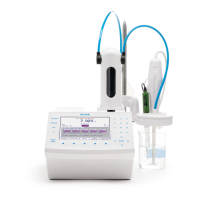Where:
C= the concentration of the titrant
F1= general factor
F2 = general factor
F3 = general factor
S = sample size, in grams or milliliters
V = the volume delivered, in liters, to reach the preset or equivalence end point (determined by the titrator)
General factors:
Weight Conversion:
One of the general factors should be a weight conversion factor.
Examples of concentration units:
mol/L moles/Liter
eq/L equivalents/Liter
g/L grams/Liter
mg/L milligram/Liter
Reaction Ratio:
The reaction ratio is the ratio between the analyte and titrant or standard and titrant.
Examples of ratios:
mol/mol moles of sample/moles of titrant
mol/eq moles of sample/equivalents of titrant
eq/mol equivalents of sample/moles of titrant
mol/mol moles of titrant/moles of standard
eq/mol equivalents of titrant/moles of standard
Example: 2 moles of NaOH react with 1 mole of H
2
SO
4
Unit Conversion factor:
Used to convert between various measurement units.
Examples: L/1000 —> mL
g/1000 —> mg
Weight Conversion factor:
Used to convert between weight measurement bases (kg, g, mg, µg, mole or mmole).
Example: g —> mol

